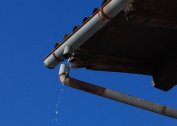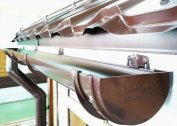Fat deposits in pipes (regardless of the material of manufacture) is a serious problem that every owner of a living room faces. It is important to timely resolve the issue of cleaning in order to prevent violations of the proper operation of the sewer system. In this case, it is not necessary to resort to the help of a plumber, you can deal with blockages yourself. There are many simple options for cleaning the water supply, for the implementation of which only cleaning products, improvised tools and a little free time are needed.
Why fat settles on pipes
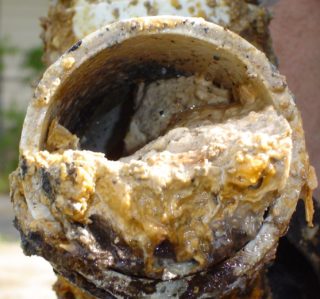 Every day, when washing dishes and pouring food debris into the toilet bowl, a large volume of water containing impurities of fat passes through the pipes. It is a mistake to think that they are completely dissolved by dishwashing agents.
Every day, when washing dishes and pouring food debris into the toilet bowl, a large volume of water containing impurities of fat passes through the pipes. It is a mistake to think that they are completely dissolved by dishwashing agents.
A large amount of fat remains and settles in the water supply and sewage system turning into an adhesive film, which layer by layer lines the pipes from the inside. Over time, threads, hair, and other small debris stick to it and a dense cork forms, through which a full drain can not be made. The appearance of an unpleasant odor is a sure sign of blockage.
Often this problem appears if sewer pipes made of cast iron are installed in the house or apartment. The rough metal structure contributes to the adherence of fatty deposits to it. If we talk about modern polypropylene and PVC pipes, then blockages in them are formed due to deformation of the material during its long-term operation.
A favorable condition for the accumulation of fat is:
- washing dishes in cold water;
- drain into the drain of a cooled soup or broth;
- washing pans and pans without the use of special tools;
- improperly installed sewerage / plumbing.
To avoid accumulation of fat, it is necessary to periodically apply preventive measures. If the blockage does occur, you can eliminate it yourself using simple methods and available means.
Chemical fat dissolution
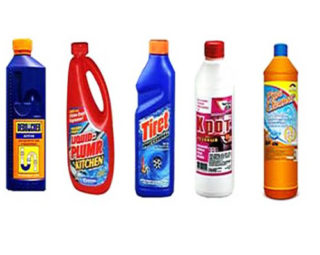 Now in each store a wide range of chemicals for pipe cleaning is presented. Such drugs are very popular and help to quickly get rid of traffic jams, completely dissolving the settled fat. Manufacturers recommend the use of compounds containing alkali and offer products that are available in various forms:
Now in each store a wide range of chemicals for pipe cleaning is presented. Such drugs are very popular and help to quickly get rid of traffic jams, completely dissolving the settled fat. Manufacturers recommend the use of compounds containing alkali and offer products that are available in various forms:
- Loose (in the form of powder or granules) - packed in plastic bags with special protection and used for 1 cleaning. They contain potent substances, therefore they require safety precautions when used.
- Liquid or gel - available in plastic containers. The main active ingredient is alkali, also the components for whitening and eliminating unpleasant odors are also included in the composition.
Among the many brands, the most effective and popular are distinguished:
- Mister Muscle;
- Mole;
- Sanox
- Selene;
- Deboucher
- Chirton;
- Pothan.
Using chemicals is quite simple. Shake the bottle (in the case of a liquid form), pour or pour the contents into the drain hole and leave for 2 hours, and then rinse with plenty of warm water. The use of chemistry requires protective equipment (rubber gloves, respirator). In case of contact with skin, it is necessary to rinse them off quickly with water.
Mechanical cleaning methods
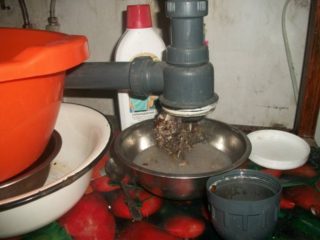 The most affordable method is the use of a plunger, which is found in almost every house. The principle of operation of this simple device is the creation of strong pressure, which contributes to the displacement of the blockage and its further destruction. For this:
The most affordable method is the use of a plunger, which is found in almost every house. The principle of operation of this simple device is the creation of strong pressure, which contributes to the displacement of the blockage and its further destruction. For this:
- Cover the drain hole with a plunger.
- Fill the sink with water to a level above the rubber valve of the fixture.
- Make several movements with the plunger without lifting it from the surface.
If the blockage is too deep and blocks the water flow almost completely, use a plumbing cable with tips in the form of a volume spring or a metal brush. Dealing with it is not as difficult as it seems:
- Unscrew the drain and siphon.
- Insert the free end of the cable into the pipe, screwing it in a circular motion.
- When reaching the fat plug, with maximum effort, scroll the cable until it passes freely through the pipe. At the same time, from time to time supply hot water to the sink so that the pieces of the cork go into the sewer.
- Pull the cable out of the pipe, clean it and lubricate it with machine oil.
- Rinse the pipe with plenty of water.
It is possible to remove fat deposits from the pipe in a hydrodynamic way with the help of a compressor that is capable of creating pressure from 190 MPa (these compact devices are easy to find on the open market). The method is effective for use in the most inaccessible places. In the process of work, it is necessary to introduce the hose nozzle into the pipe to a depth of 50-60 cm and connect the compressor. The system will work automatically, progressing farther and farther through the water supply thanks to jet propulsion. The nozzle is selected depending on the severity of the blockage (universal, penetrative, chain-rotary).
If you can’t deal with the problem yourself, call specialists who have professional equipment. Thanks to thermochemical and pneumohydroimpulse cleaning, they will eliminate the problem in the shortest possible time.
Folk remedies
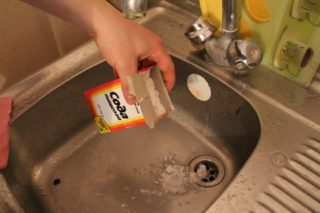 For cleaning pipes from grease, do not immediately use aggressive chemicals or mechanical methods. You can try to do with simple and affordable substances that every housewife has. First of all, it is baking soda. As a result of a violent reaction with the addition of acetic acid, lemon and hot water, foam is formed from bubbles of carbon dioxide. It creates pressure in the pipes and cleans them from fat deposits. But you can only use this combination of ingredients for polypropylene or PVC.
For cleaning pipes from grease, do not immediately use aggressive chemicals or mechanical methods. You can try to do with simple and affordable substances that every housewife has. First of all, it is baking soda. As a result of a violent reaction with the addition of acetic acid, lemon and hot water, foam is formed from bubbles of carbon dioxide. It creates pressure in the pipes and cleans them from fat deposits. But you can only use this combination of ingredients for polypropylene or PVC.
Procedure:
- Pour 0.5 cups of soda into the drain.
- Pour 1 cup vinegar or citric acid solution (25 g per 250 ml of hot water).
- Close the drain plug with a stopper for 20 minutes.
- Drain a large volume of hot tap water into the system.
For cleaning iron and cast iron pipes, it is better to use a more gentle method to avoid destruction of the inner protective layer and to prevent metal corrosion. For this:
- Pour 1 cup of soda into the drain.
- Pour 1 liter of hot water and cover the hole with a stopper for 15-20 minutes.
- Flush the system with hot water.
To clean both iron and plastic pipes, you can use chlorine bleaches or toilet cleaners. It is necessary:
- Pour 1 liter of funds into the system and leave for an hour.
- Flush pipes with plenty of water.
Prevention
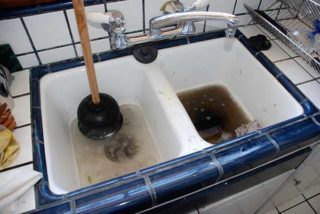 To prevent mass accumulation of fatty deposits on the pipes and the formation of complex blockages, it is better to regularly carry out preventive measures:
To prevent mass accumulation of fatty deposits on the pipes and the formation of complex blockages, it is better to regularly carry out preventive measures:
- Do not save on water with excessive fanaticism. If the required amount of liquid does not enter the pipes, their natural purification does not occur. Sewer is especially needed for hot water, which breaks down fat well.
- Do not use the toilet as a trash bin. It is not recommended to throw there even toilet paper, not to mention the drain of fat from pans, soup and broth. The best way is to collect them in a container and throw them away with garbage.
- Install the nets on the kitchen sink and on the drain hole in the bathroom. This will prevent hair and food residues from entering the pipes, which will not stick to the sticky layer of fat and form a cork.
- Once every six months, clean the drain system with soda, boiling water and vinegar.It is fast, safe and very effective.
- Do not trust the installation of sewage and water supply to dubious plumbers.
- Remember that pipes have their own operational resource. Its significant excess can disable the entire sewer system.
It is recommended to owners of private houses to constantly monitor the water level in sewer wells so that their contents do not exit through the drain holes in the kitchen and in the bathrooms. This is especially dangerous if the system is not equipped with a check valve on the exhaust pipe.
Remember that blockages always occur unexpectedly and create serious discomfort for those living in an apartment or a private house. To ensure a long and uninterrupted operation of the water supply and sewage systems, it is necessary to ensure proper and timely care of the pipes, as well as to put protective equipment on the drain holes.
